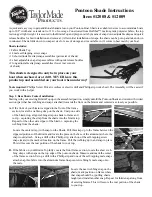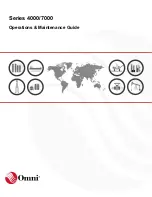
6
You, the operator in control, are responsible for using good,
safe judgment in the operation of the Turf Tender and ensuring
that no one will be injured by it’s operation.
Passengers
Never carry passengers on this Turf Tender. The Turf
Tender is not designed to carry anybody.
Operate Carefully
Using the Turf Tender demands attention to operation.
Failure to operate the Turf Tender safely may result in an
accident, tip over, or serious injury or death. To prevent tipping
or loss of control:
1. The Turf Tender is designed to be operated in forward
with the operator positioned to the side of the machine.
Do not walk backwards looking at the machine. Always
watch where you are going.
2. Operate only at a travel speed you are comfortable with.
Use extreme caution, reduce speed, and maintain a safe
distance when operating around sand traps, ditches, creeks,
trees, ramps, unfamiliar areas, or other hazards.
3. Be alert for severe ground depressions, holes, or other
hidden hazards. If an outside wheel drops into a hole, it
may cause the Turf Tender to tip over.
4. Use caution when operating the Turf Tender on slopes.
Normally travel straight up or down slopes. Operate at a
slow speed when either going up or down a slope.
5. Avoid making turns on slopes.
6. Reduce speed when making turns.
7. Use extra caution and slow travel speed when operating
on wet surfaces, at higher speeds, or with a full load.
NOTE: A worst-case control scenario exists when
the Turf Tender is being operated down a wet slope
at an angle to the slope and the operator is
attempting to turn. Loss of control could result in
an accident, tip over and serious injury or death.
8. Avoid sudden stops and starts. Do not go from forward to
reverse or from reverse to forward without coming to a
complete stop.
9. Do not attempt sharp turns or abrupt maneuvers or other
unsafe operating actions which may cause loss of control.
SAFE OPERATIONAL PRACTICES
10. If the engine stalls or the Turf Tender loses headway on
a hill, never attempt to turn the vehicle around. Always
back straight down the hill slowly in reverse.
11. Make sure the area is clear prior to operating.
12. Always avoid low hanging objects such as tree limbs,
doorways, door jambs, power lines, etc. Ensure there is
enough clearance for both you and the Turf Tender.
13. Always avoid objects, which may “hook” the wheels such
as trees, posts, etc. Be constantly aware of the width and
turning radius of the Turf Tender. Failure to do so may
result in damage to the Turf Tender.
14. Watch out for traffic when near or crossing roads. Always
yield the right of way to pedestrians and other vehicles.
This vehicle was not designed for travel on streets or
highways. Obey all traffic rules and regulations pertaining
to controlled and uncontrolled traffic areas.
15. Limit load size if working on steep or rough terrain.
16. STOP and ask your supervisor if you are ever unsure
about safe operation.
LOADING
When loading material, distribute the load evenly to keep it
from shifting. Operate the Turf Tender with extra care when
the hopper is full of heavy material.
Slowly fill the hopper over a few seconds of time with the
loader bucket as low as possible. Avoid “dropping” the load
into the hopper from an excessively high loader bucket. This
is safer in terms of maintaining a balanced load and will also
extend the life of the Turf Tender.
Make sure the material you are loading has uniform
properties. Material that has few small rocks in it poses a
projectile hazard. Material that has varying composition or
moisture may result in widely varying application rates.
Do not exceed the load capacity of the Turf Tender. Refer
to the Specifications section to determine the maximum load
capacity of the Turf Tender.
Never add sideboards to the hopper to increase its capacity
for dense or heavy materials. The additional weight will increase
the chance of tipping or rolling over. The hopper capacity of
the may be increased for low-density materials such as peat.






































